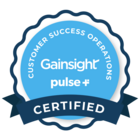Hi community - looking for some insight from our customers who currently leveraging Business Modeler to understand the impact it has had from a maintenance perspective in your admin duties? Do you find after initial setup that it does not add too much? Asking for a friend ;)
Sign up
If you ever had a profile with us, there's no need to create another one.
Don't worry if your email address has since changed, or you can't remember your login, just let us know at community@gainsight.com and we'll help you get started from where you left.
Else, please continue with the registration below.
Welcome to the Gainsight Community
Enter your E-mail address. We'll send you an e-mail with instructions to reset your password.



